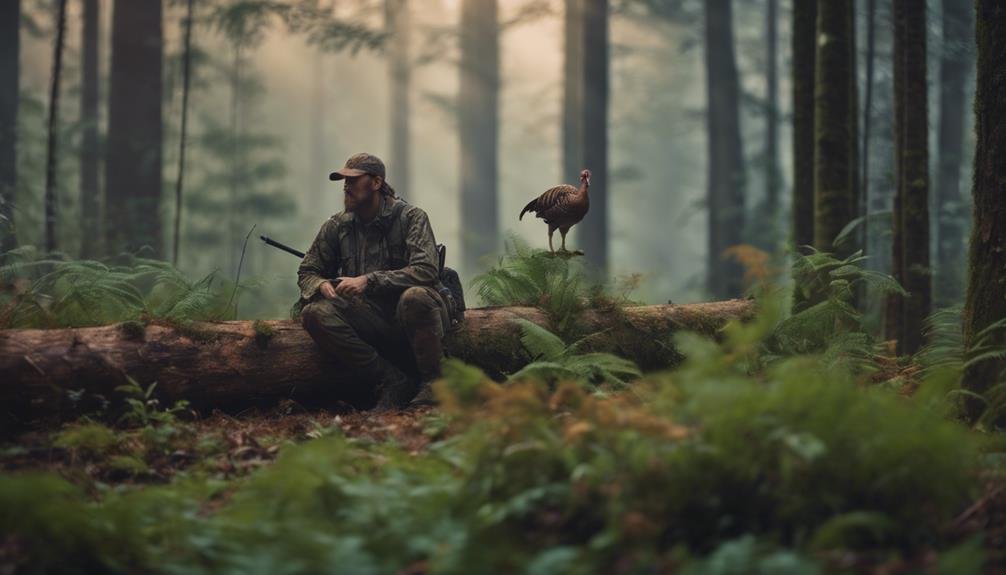Wild turkeys possess a sophisticated communication system, comprising at least 29 distinct vocalizations that convey crucial information about food sources, predators, and mating opportunities, making them one of the most vocal birds in the animal kingdom. Each call serves a specific purpose in their complex communication system, maintaining flock dynamics and facilitating social interactions. By deciphering these call patterns, hunters can gain a deeper understanding of turkey behavior and psychology, ultimately increasing their chances of success. As we explore the intricacies of turkey talk, the secrets of this complex language begin to reveal, disclosing a world of nuance and complexity.
Key Takeaways
- Wild turkeys possess at least 29 distinct vocalizations, each serving a specific purpose in their complex communication system.
- Understanding turkey call patterns is essential to deciphering their behavior and communication.
- Effective calling strategies rely on a deep understanding of turkey behavior and vocalizations, including social dynamics and territorial behaviors.
- Adapting calling strategies in real-time increases the chances of a successful hunt, taking into account environmental factors like wind direction and terrain.
- Mastering various calls for every occasion, including seasonal calls like the springtime gobble, increases the chances of success and engages the hunter in a more immersive experience.
Turkey Vocalizations and Calls
Wild turkeys possess a remarkable repertoire of at least 29 distinct vocalizations, ranking them among the most vocal of birds, with each call serving a specific purpose in their complex communication system. This diverse range of calls plays a pivotal role in maintaining flock dynamics, facilitating social interactions, and conveying essential information. Different call patterns serve as a language, enabling turkeys to convey information about food sources, predators, and mating opportunities. For instance, the 'yelp' call is used by hens to locate their poults or signal receptivity to breeding, while the 'cluck' call is used to get attention or signal alarm. Understanding these call patterns is essential for deciphering turkey behavior and communication, providing valuable insights into their social structure and behavior.
Hunting the Wild Bird
As hunters seek to engage with their quarry, a deep understanding of turkey behavior and vocalizations becomes essential in the pursuit of a successful hunt. In wild encounters, hunters must tap into the bird's instinct, using subtle calling strategies to entice the turkey into range. Effective communication is key, as hunters must adapt to the turkey's mood and environment.
| Hunting Strategy | Turkey Behavior | Vocalization |
|---|---|---|
| Stalking | Aggressive | Loud, Insistent Yelp |
| Calling | Curious | Soft, Gentle Cluck |
| Ambushing | Cautious | Silent Observation |
Gear and Equipment Essentials
Turkey hunters often carry a range of specialized gear, including multiple calls, vests, and other equipment, which can greatly impact the success of a hunt. Effective gear management is essential, as it allows hunters to quickly access the right tools for the situation. A well-organized vest is imperative, enabling hunters to swiftly retrieve the necessary gear without disrupting the hunt. Proper gear maintenance is also indispensable, as malfunctioning equipment can be detrimental to the hunt. Regular cleaning and inspection of calls, vests, and other gear can prevent mechanical failures and guarantee peak performance. By prioritizing vest organization and gear maintenance, hunters can increase their chances of success and enhance their overall hunting experience.
Pressured Turkeys and Adaptation
When confronted with pressured turkeys, hunters must adapt their calling strategies to overcome the birds' heightened wariness, which can render traditional tactics ineffective. Pressured turkeys require a nuanced approach, as they have become increasingly wary of loud, aggressive calling. In response, hunters should employ silent hunting techniques, relying on stealth and patience to get close to their quarry. Fresh approaches, such as soft, subtle calling, can be more effective in these situations. By adjusting their strategy to accommodate the turkeys' increased caution, hunters can increase their chances of success. This adaptive approach requires a deep understanding of turkey behavior and communication, as well as a willingness to think on one's feet and adjust tactics accordingly.
Calls for Every Occasion
Within the context of turkey hunting, employing the right call for a given situation can substantially enhance the hunter's chances of success, and a well-stocked vest should include a range of calls suited to various environments, behaviors, and scenarios. Different vocalization styles are required for different occasions, such as morning chatter for early risers or woodland whispers for stealthy approaches. Seasonal calls, like the distinctive springtime gobble, are also essential for mimicking the turkey's natural behavior. Understanding flock dynamics and adapting calls to the specific hunting scenario can create a harmonious exchange between hunter and bird. By mastering various calls for every occasion, hunters can increase their chances of success and engage in a more immersive hunting experience.
Decoding Turkey Behavior
In the intricate social hierarchy of wild turkeys, behavioral cues and vocalizations are inextricably linked, with subtle changes in posture, feather positioning, and vocal tone conveying vital information about dominance, courtship, and alarm. Within a flock, turkeys establish a clear social hierarchy, with dominant birds leading subordinate ones. This hierarchy is maintained through a complex interplay of visual and auditory cues, including vocalizations, feather positioning, and aggressive displays. Flock dynamics are shaped by these interactions, influencing foraging behavior, roosting patterns, and mating strategies. Understanding these behavioral cues is essential for deciphering the secret language of wild turkeys, providing valuable insights into their social organization and communication patterns. By recognizing these subtle cues, hunters and wildlife enthusiasts can better appreciate the intricate social dynamics of these fascinating birds.
The Art of Communication
Among the 29 distinct vocalizations documented in wild turkeys, each call plays a pivotal role in conveying specific information, facilitating the complex social dynamics that govern their behavior. Verbal cues, such as yelps, clucks, and gobbles, serve as essential tools for communication. Nonverbal signals, including postures and visual displays, also play a key role in conveying information.
| Verbal Cues | Nonverbal Signals |
|---|---|
| Yelp (locator call) | Wing-flapping (agitation) |
| Cluck (attention call) | Strutting (courtship display) |
| Gobble (mating call) | Feather ruffling (aggression) |
Understanding Yelp and Cluck
Turkey vocalizations, including the yelp and cluck, are fundamental components of their complex communication system, conveying essential information about the caller's identity, location, and intentions. These vocalizations play a vital role in maintaining Turkey Sociality and Flock Dynamics.
- Yelping is often used by hens to locate their young or other flock members, facilitating social reunions and reinforcing flock bonds.
- Clucking, on the other hand, serves as a contact call, helping turkeys maintain proximity and coordination within their social groups.
- By understanding the nuances of yelp and cluck, we can better appreciate the intricate dynamics of turkey sociality and flock behavior, ultimately informing our approach to hunting and conservation strategies.
Gobbling and Mating Calls
Beyond the social bonding facilitated by yelps and clucks, the turkey's reproductive cycle is heralded by a distinctive vocalization: the gobble, a low-frequency, resonant call that serves as the only true mating call of the species. During the spring breeding season, male turkeys, or gobblers, engage in a ritualistic display of Gobbler Etiquette, where they vocalize to establish dominance and attract mates. This Spring Serenade is a critical component of turkey behavior, as it allows males to showcase their fitness and attract females. The gobble is a unique vocalization that can be heard from great distances, allowing males to advertise their presence to potential mates. This call is a pivotal aspect of turkey communication, playing a fundamental role in the species' reproductive cycle.
Turkey Talk Strategies
Effective communication with wild turkeys relies on a hunter's ability to decode and replicate the species' diverse vocalizations, requiring a strategic approach to turkey talk.
To master turkey talk, hunters must employ various tactics to engage and converse with their quarry. Three key strategies are:
- Conversational flow: Hunters should aim to create a natural, back-and-forth conversation with the turkey, using a mix of calls and pauses to mimic real-life turkey interactions.
- Call variation: Using a range of calls, from soft yelps to loud gobbles, allows hunters to adapt to changing situations and keep the turkey engaged.
- Environmental awareness: Hunters should be aware of their surroundings and adjust their calling strategy accordingly, taking into account factors like wind direction, terrain, and other environmental factors.
Mastering the Hunt
Successfully mastering the hunt requires a deep understanding of turkey behavior and vocalizations, as well as the ability to adapt calling strategies to suit the specific hunting environment and situation. Effective Hunt Preparation involves studying turkey psychology, including their social dynamics, territorial behaviors, and communication patterns. By understanding these factors, hunters can tailor their calling strategies to maximize their chances of success. This may involve using subtle, soft calling for pressured turkeys or more aggressive calling for dominant toms. A thorough understanding of turkey behavior and vocalizations enables hunters to make informed decisions and adapt their strategies in real-time, increasing their chances of a successful hunt.
Frequently Asked Questions
Can Domesticated Turkeys Understand Wild Turkey Vocalizations?
Domesticated turkeys, having diverged from wild ancestors, retain some innate recognition of wild turkey vocalizations, but their understanding is limited by reduced flock dynamics and vocal imitation capabilities compared to their wild counterparts.
How Do Weather Conditions Affect Turkey Behavior and Calls?
Coincidentally, wild turkeys possess an innate ability to sense changes in atmospheric pressures, behaving as bird barometers, which notably influence their vocalizations, feeding patterns, and movement, making them more vigilant and vocal during turbulent weather conditions.
Can a Hunter's Scent Affect Turkey Behavior During a Hunt?
A hunter's scent can greatly impact turkey behavior during a hunt, as wild turkeys possess a keen sense of smell, making scent control a vital aspect of effective hunting strategies.
Do Turkey Calls Vary by Region or Geographic Location?
Like a linguistic tapestry, turkey calls weave together regional accents and dialect diversity, varying by geographic location, where local nuances and adaptations shape the vocalizations, creating a rich diversity of sounds that echo through the landscape.
Can Turkeys Recognize and Remember Individual Human Voices?
Research suggests that turkeys can recognize and remember individual human voices through distinctive vocal cues, forming human bonds, and adapting to familiar sounds, implying a level of auditory cognition and memory in wild turkeys.
Conclusion
Ultimately, deciphering the wild turkey's secret language is vital for successful hunting. By understanding the various vocalizations, hunters can employ effective call-and-response strategies to outmaneuver their quarry. Through careful study of turkey communication, hunters can adapt to pressured birds, master the hunt, and ultimately, secure a prized trophy. By grasping the intricacies of turkey talk, hunters can elevate their skills, refine their techniques, and ultimately, triumph in the hunt.









